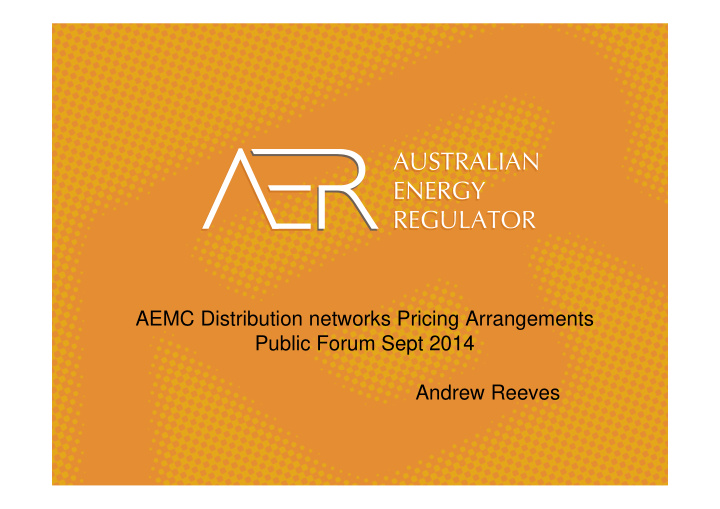



AEMC Distribution networks Pricing Arrangements Public Forum Sept 2014 Andrew Reeves
AER Perspective • Overview on Draft Decision • Pricing Principles • Process
Overview on Draft Decision • Background to this development • Criticality of Tariff Reform • Three foundation elements of Power of Choice Implementation: – Contestability of Metering – Consumer access to own data – Cost-reflective tariffs
Implementation of Innovation • There’s need to address changes in network usage • There’s now cost-effective technology • Metering & communication systems • There’s need to deal with institution change Pricing structures > Temporal & Spatial differentiation Players > active participation by customers & customer agents (retailers, alternative suppliers/solution providers – generation, storage, load control) • There’s need for Community Licence for change
Rocky Mountain Institute
Complexity and Customer Experience • Most customers are likely to prefer simple solutions • Even complex network tariffs can be translated to a simple customer experience e.g. by ‘solution providers’ managing load • Complexity of tariffs should not be a barrier to cost- reflective tariffs being offered by DNSPs- as an option
Implementation of cost-reflective prices • LONGER-TERM - More sophisticated possibilities: – Real-Time Pricing – Attribute-Based Pricing – Distribution Locational Marginal Pricing • NEAR-TERM - Default or opt-in/opt-out possibilities: – Time-of-Use Pricing – Energy + Capacity Pricing (i.e. demand charges) – Distribution “Hot Spot” Credits after Rocky Mountain Institute Power of Choice included suggestions for transition (opt-in and opt-out choices for customers) – these could be acknowledged in the Decision
Key Consideration- community licence Power of Choice: “the reforms should be implemented in a timely manner and be supported by an effective consumer awareness and education strategy” Good elements in the Draft Rule > Consultation & Consumer Impact Assessment - but: the issues are significant and the DNSP consultation process alone may be too narrow, given the potential scale of change which will potentially impact all customers.
Guideline or Guidance? • Time limited for AER to develop Guideline: • Guideline might not be best approach at early stage • Guidance desirable: • Shared understanding of issues, objectives, methods, transitions, impacts: • Policy makers • Governments • Network Businesses • Retailers / new business models • Consumers & their representatives • Regulators • Foundation for network-specific consultation & approvals
More on guidance on implementation • While solutions should be specific to network characteristics, common principles are desirable: – Process like AER Better Regulation approach to development of its guidelines allows all parties to participate in the discussion and develop a common understanding = better able to address network-specific proposals – Consultation/ workshop process could develop a Resources Kit for development of TSS – inc. practical means to address network issues and consumer impact – Inclusive approach may give Government confidence that consumer concerns are addressed, lessening need for side constraints. – Build on substantial work already undertaken by AEMC and others, but with wider engagement – Important work for new Energy Consumers Australia • Who/how? – AEMC? AEMC / AER?
Conclusion • Importance of transition mechanisms to cost-reflective prices, not losing sight of the longer term • A process for further guidance for Tariff Strategies, drawing on existing work • Inclusive development for shared understanding of needs, issues, solutions and managing of potential impacts • Important work for ECA
Recommend
More recommend